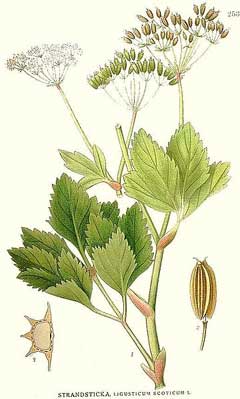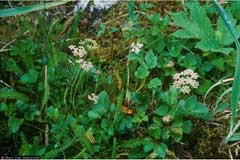 |
|
http://commons.wikimedia.org/wiki/File:253_Ligusticum_scoticum.jpg |
 |
| Mary Clay Stensvold @ USDA-NRCS PLANTS Database |
Translate this page:
Summary
Physical Characteristics

 Ligusticum scoticum is a PERENNIAL growing to 0.6 m (2ft).
Ligusticum scoticum is a PERENNIAL growing to 0.6 m (2ft).
See above for USDA hardiness. It is hardy to UK zone 4 and is not frost tender. It is in flower from July to August, and the seeds ripen from August to September. The species is hermaphrodite (has both male and female organs) and is pollinated by Insects. The plant is self-fertile.
Suitable for: light (sandy), medium (loamy) and heavy (clay) soils and prefers well-drained soil. Suitable pH: mildly acid, neutral and basic (mildly alkaline) soils. It cannot grow in the shade. It prefers dry or moist soil. The plant can tolerate maritime exposure.
UK Hardiness Map
US Hardiness Map
Synonyms
Plant Habitats
Woodland Garden Sunny Edge; Dappled Shade; Cultivated Beds;
Edible Uses
Edible Parts: Leaves Root Seed Shoots Stem
Edible Uses: Condiment
Leaves, flowers and young shoots - raw or cooked[2, 4, 5, 100]. Strong and not very pleasant[115]. Superb in salads[172]. The leaves are usually blanched in order to make the flavour milder[61, 183], though this also reduces the nutritional value[K]. A celery-like flavour, it is used as a seasoning in salads, soups etc[183]. Another report says that the flavour is more like parsley[245]. Stem - used as a flavouring in soups, stews etc[5, 17]. A celery-like flavour[238]. The green stem is peeled and eaten[183]. Root - raw or cooked[2, 5, 161]. A sweet flavour[161]. Seed - ground into a powder and used as a flavouring in soups and stews[172, 238, 245]. A sharp, hot taste it is used in the same ways as pepper[245]. The young shoots and roots are occasionally candied like angelica[183].
References More on Edible Uses
Medicinal Uses
Plants For A Future can not take any responsibility for any adverse effects from the use of plants. Always seek advice from a professional before using a plant medicinally.
Aromatic Carminative Deodorant Stimulant
The root is aromatic and carminative[4]. It is used in the treatment of hysterical and uterine disorders[4, 238]. The seeds are sweetly aromatic and have been used as a carminative, deodorant and stimulant[4, 172, 238]. They are also sometimes used for flavouring other herbal remedies[4].
References More on Medicinal Uses
The Bookshop: Edible Plant Books
Our Latest books on Perennial Plants For Food Forests and Permaculture Gardens in paperback or digital formats.

Edible Tropical Plants
Food Forest Plants for Hotter Conditions: 250+ Plants For Tropical Food Forests & Permaculture Gardens.
More

Edible Temperate Plants
Plants for Your Food Forest: 500 Plants for Temperate Food Forests & Permaculture Gardens.
More

More Books
PFAF have eight books available in paperback and digital formats. Browse the shop for more information.
Shop Now
Other Uses
References More on Other Uses
Cultivation details
Succeeds in any well-drained soil in a sunny position[1, 200]. Dislikes shade. Succeeds in dry soils[238]. Plants are hardy to at least -15°c[238]. Scottish lovage has occasionally been cultivated as a pot herb, though it has been largely supplanted by celery[1, 4, 17]. All parts of the plant are aromatic when bruised, the aroma being likened to a mixture of parsley, angelica and pear skin[245]. For polyculture design as well as the above-ground architecture (form - tree, shrub etc. and size shown above) information on the habit and root pattern is also useful and given here if available. The plant growth habit is a clumper with limited spread [1-2]. The root pattern is a tap root similar to a carrot going directly down [1-2].
References Carbon Farming Information and Carbon Sequestration Information
Temperature Converter
Type a value in the Celsius field to convert the value to Fahrenheit:
Fahrenheit:
The PFAF Bookshop
Plants For A Future have a number of books available in paperback and digital form. Book titles include Edible Plants, Edible Perennials, Edible Trees,Edible Shrubs, Woodland Gardening, and Temperate Food Forest Plants. Our new book is Food Forest Plants For Hotter Conditions (Tropical and Sub-Tropical).
Shop Now
Plant Propagation
Seed - the seed only has a short period of viability and so is best sown as soon as it is ripe in a cold frame in the autumn. Stored seed should be sown as early in the year as possible in a greenhouse or cold frame[200]. Prick out the seedlings into individual pots when they are large enough to handle and plant them out into their permanent positions in the summer if they have grown large enough. Otherwise, keep them in a cold frame for the first winter and plant them out in early summer. Division of the rootstock in early spring. Make sure that each section of root has at least one growth bud. Very easy, larger clumps can be replanted direct into their permanent positions, though it is best to pot up smaller clumps and grow them on in a cold frame until they are rooting well. Plant them out in the spring.
Other Names
If available other names are mentioned here
Native Range
TEMPERATE ASIA: Japan, Kamcatskij kraj, Korea, Magadanskaja oblast,Russian Federation. NORTHERN AMERICA: Greenland, United States, Alaska, Connecticut, Maine, Massachusetts, New Hampshire, Rhode Island, Canada, Québec, Nova Scotia, Ontario, Prince Edward Island, New Brunswick, Newfoundland and Labrador, British Columbia (west), EUROPE: Denmark, United Kingdom (U.K.), Iceland, Norway, Sweden, Russian Federation-European part, European part,
Weed Potential
Right plant wrong place. We are currently updating this section.
Please note that a plant may be invasive in one area but may not in your area so it's worth checking.
Conservation Status
IUCN Red List of Threatened Plants Status :

Growth: S = slow M = medium F = fast. Soil: L = light (sandy) M = medium H = heavy (clay). pH: A = acid N = neutral B = basic (alkaline). Shade: F = full shade S = semi-shade N = no shade. Moisture: D = dry M = Moist We = wet Wa = water.
Now available:
Food Forest Plants for Mediterranean Conditions
350+ Perennial Plants For Mediterranean and Drier Food Forests and Permaculture Gardens.
[Paperback and eBook]
This is the third in Plants For A Future's series of plant guides for food forests tailored to
specific climate zones. Following volumes on temperate and tropical ecosystems, this book focuses
on species suited to Mediterranean conditions—regions with hot, dry summers and cool, wet winters,
often facing the added challenge of climate change.
Read More
Expert comment
Author
L.
Botanical References
17200
Links / References
For a list of references used on this page please go here
Readers comment
| Add a comment |
|
If you have important information about this plant that may help other users please add a comment or link below. Only comments or links that are felt to be directly relevant to a plant will be included. If you think a comment/link or information contained on this page is inaccurate or misleading we would welcome your feedback at [email protected]. If you have questions about a plant please use the Forum on this website as we do not have the resources to answer questions ourselves.
* Please note: the comments by website users are not necessarily those held by PFAF and may give misleading or inaccurate information.
To leave a comment please Register or login here All comments need to be approved so will not appear immediately.
|
Subject : Ligusticum scoticum
|
|
|
|